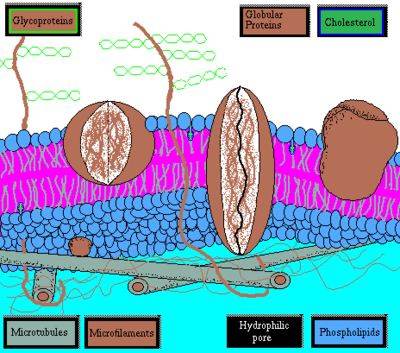General Biology/Cells/Membranes
< General Biology < CellsGeneral Biology | Getting Started | Cells | Genetics | Classification | Evolution | Tissues & Systems | Additional Material
Biological membranes

Biological membranes surround cells and serve to keep the insides separated from the outsides. They are formed of phospholipid bilayers, which by definition are a double layer of fatty acid molecules (mostly phospholipids, lipids containing lots of phosphorus).
Proteins serve very important functions in cellular membranes. They are active transports in and out of the cell, acting as gatekeepers. They relay signals in and out of the cell. Proteins are the site of many enzymatic reactions in the cell, and play a role in regulation of cellular processes.
Phospholipid
Phospholipid bilayer
- basis of biological membranes and cellular organisms
- contains a charged, hydrophilic (attracted to water) head and two hydrophobic (repelled by water) hydrocarbon tails
- In presence of water, phospholipids form bilayer
- maximize hydrogen bonds between water
- creates barrier to passage of materials
- fluid mosaic model shows horizontal (common) and "flip-flop" (rare) movement of phospholipids
Fluid mosaic model
- Current model of membrane
- Phospholipid bilayer
- Phospholipids
- Move freely in lipid layer, but rarely switch layers
- Different phospholipids in each layer in different organelles
- Glycolipids
- Sterols (cholesterol in animals)
- Transmembrane proteins "float" in fluid lipid bilayer
- also called intrinsic, integral proteins
- Exterior (extrinsic, peripheral) proteins
Membrane proteins
- Transport channels
- Enzymes
- Cell surface receptors
- Cell surface identity markers
- Cell adhesion proteins
- Attachments to cytoskeleton
Integral membrane proteins
- Anchoring to membrane
- Protein has attached phosphatidylinositol (GPI) linkage, anchors protein in outer layer (no picture)
- Protein has one or more hydrophobic transmembrane domains
- -helix
- -sheet
Channel protein Transport across membranes * Diffusion
- From higher concentration to lower concentration
- Membranes are selectively permeable
- Ions diffuse through membrane channels
- Selective
- Movement determined by diffusion and voltage differences
- Facilitated diffusion
- Carrier protein, physically binds transported molecule
- Osmosis
- Diffusion of water down concentration gradient
- In cell: various solutes (amino acids, ions, sugars, etc.)
- interact with water, e.g., hydration shells
- Water moves through aquaporin channels into cell
- Depends upon the concentration of all solutes in solution
- Hyperosmotic solution: higher concentration of solutes
- Hypoosmotic solution: lower concentration of solutes
- Isoosmotic solution: solute concentrations equal
- Water moves from hypoosmotic solution to hyperosmotic solution
Osmotic pressure Bulk transport
- Endocytosis: energy requiring
- Phagocytosis
- Solid material, typically food
- Pinocytosis
- Primarily liquid
** Receptor-mediated endocytosis
- Pits on cell surface coated with clathrin and receptors
- Bind specific proteins
- Exocytosis
- Discharge of materials from vesicle at cell surface
Receptor-mediated endocytosis
Active transport
- Energy required (usuallyننةىة
- Highly selective
- Works against concentration gradient
- Many examples, e.g., Na+/K+ pump
Cotransport (coupled transport)
- Does not use ATP directly
- Molecule is transported in connection with another molecule that is moving down a concentration gradient
- Example: Na+ gradient is established by a Na+ pump, with higher concentration on outside of cell. Cotransport channel carries Na+ and another molecule (e.g. glucose) into cell
- May involve proton (H+) pumps (chemiosmosis - ATP production)
This text is based on notes very generously donated by Dr. Paul Doerder, Ph.D., of the Cleveland State University.